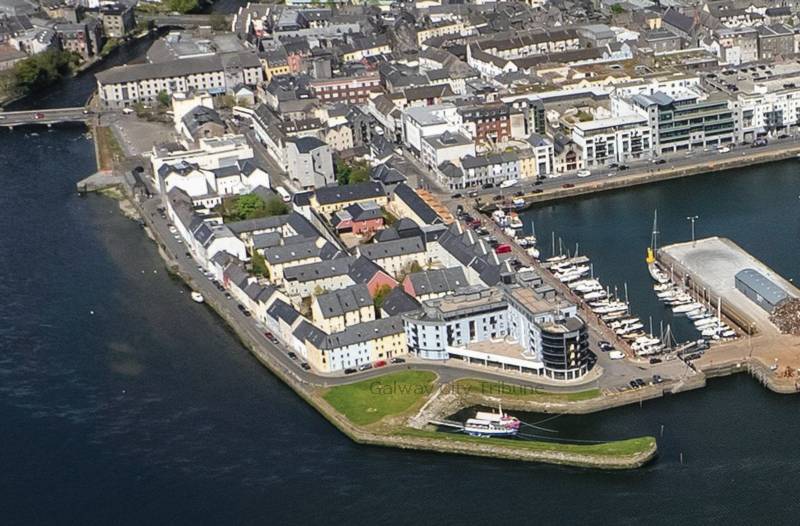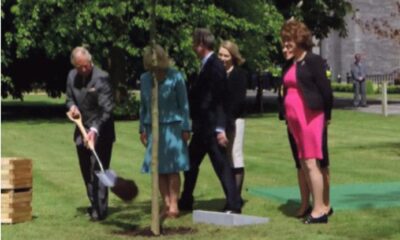CITY TRIBUNE
Businessman loans e-bikes and scooters to HSE workers

A Galway company which rents out electric bikes and scooters is providing free transport for healthcare workers struggling to get to work.
Colin Barry, owner of Brite Mobility, heard that frontline workers were too scared to use their own cars if sharing with their families. They also were finding it difficult to use public transport since schedules were scaled back due to the drastic cut in the numbers of people working. Many were afraid to even get on a bus or into a taxi in case they were infected.
He got in touch with the HSE offering hospital staff the use of his vehicles during the lockdown.
“We have 65 e-bikes and e-scooters on loan now to mainly nurses and doctors. The feedback has been overwhelmingly positive. We have one consultant coming in as far as Barna, others are scattered across Knocknacarra, Doughiska, Salthill. They don’t share them due to coronavirus, so they have full use of it while they need it for work,” he explained.
“The HSE nationally ramped up hours so they are working really long hours so they need to get in and out of work quickly. Now it’s taking them 15 minutes to commute – instead of 45 minutes to an hour.”
While Colin is at home taking care of his three-month-old baby and two-year-old son, he has three staff looking after maintenance, technical issues and customer service.
He predicts he will be able to absorb the cost of allowing the HSE staff to use his electric devices for a month or two before he will have to pull the plug. He is hoping for corporate donations or for members of the public to pledge their financial support through an online fundraising page.
So far, €1,300 has been donated for the scheme with a target set of €6,000.
Colin set up Brite Mobility last July after his family sold their car dealership, Motorpark (Barry Motors) on the Headford Road, which had been established by his grandfather.
Colin is convinced that shared electric vehicles are the way forward for city transport following the huge success of similar schemes in major cities in the world such as London, Barcelona and New York.
While push bike schemes – such as the Coca Cola Bike Scheme in Galway – have been a bit hit in the likes of Dublin, they have not really captured the public imagination in smaller cities like Galway.
With legislation due to be enacted by the incoming government regulating the use of e-scooters on public roads, he hopes to be the first to bring in a rental scheme in Galway, Limerick and Cork.
“In the UK some of the shared e-bikes and e-scooters have had eight times the take-up of push bike schemes – electric really is the key. They go at 25km/h, people can wear a suit and arrive at work without having to shower and it’s much cheaper than keeping a car on the road,” he enthuses.
“We’re hoping to partner up with some of the American multinationals to set up schemes for employees to cut down on the traffic jams and free up parking space. At the moment, we’re looking at a €150 commuter charge but we hope to bring that down.”
An e-bike can cost around €2,000 while an e-scooter will set you back around €600. The beauty of renting them is the company takes care of the maintenance.
Since setting up on Eyre Street and before the coronavirus lockdown, there has been an average rental of between 20 and 30 e-bikes or scooters, mainly to tourists. The daily rental for an e-bike is €30 while an e-scooter costs €20.
Users sign up to an app with their bank cards, scan their details when they take it out and return the device to the designated point. If a scheme similar to the Coca Cola bikes was rolled out, there would be stations dotted across the city and suburbs.
“We’ve had town centre employees who live in Salthill, Knocknacarra and Mervue using it. A lot of students use them to go to work or grinds. We’ve had social workers who get off the train at Eyre Square and then use them to get to appointments.
“The use case is huge. I really believe this is the future for getting people around Irish cities. Our reliance on cars to the detriment of people’s lives and the environment can’t go on.”
E-bikes can do 70km before needing a charge, while scooters go as far as 16km.
The new legislation will likely outlaw their use on footpaths and by those under 16. There will also be a power limit of 350 watts, which is the industry standard and mandatory use of helmets.
He has already held discussions with Galway City Council about partnering up to roll out a scheme across town but little progress has yet been made.
“Bringing micro-mobility to transport infrastructure is the norm across Europe and the world. Ireland is just way behind. We work with a lot of the big suppliers so could push to 1,000 devices very quickly if we need to.”
To help fund the transport for healthcare workers, log onto GoFundMe.
Please remember that without advertising revenue and people buying or subscribing to our newspapers, this website and our social media channels would not exist. You can subscribe to the digital edition of the Tribune HERE.
CITY TRIBUNE
Galway ‘masterplan’ needed to tackle housing and transport crises

From the Galway City Tribune – An impassioned plea for a ‘masterplan’ that would guide Galway City into the future has been made in the Dáil. Galway West TD Catherine Connolly stated this week that there needed to be an all-inclusive approach with “vision and leadership” in order to build a sustainable city.
Deputy Connolly spoke at length at the crisis surrounding traffic and housing in Galway city and said that not all of the blame could be laid at the door of the local authority.
She said that her preference would be the provision of light rail as the main form of public transport, but that this would have to be driven by the government.
“I sat on the local council for 17 years and despaired at all of the solutions going down one road, metaphorically and literally. In 2005 we put Park & Ride into the development plan, but that has not been rolled out. A 2016 transport strategy was outdated at the time and still has not been updated.
“Due to the housing crisis in the city, a task force was set up in 2019. Not a single report or analysis has been published on the cause of the crisis,” added Deputy Connolly.
She then referred to a report from the Land Development Agency (LDA) that identified lands suitable for the provision of housing. But she said that two-thirds of these had significant problems and a large portion was in Merlin Park University Hospital which, she said, would never have housing built on it.
In response, Minister Simon Harris spoke of the continuing job investment in the city and also in higher education, which is his portfolio.
But turning his attention to traffic congestion, he accepted that there were “real issues” when it came to transport, mobility and accessibility around Galway.
“We share the view that we need a Park & Ride facility and I understand there are also Bus Connects plans.
“I also suggest that the City Council reflect on her comments. I am proud to be in a Government that is providing unparalleled levels of investment to local authorities and unparalleled opportunities for local authorities to draw down,” he said.
Then Minister Harris referred to the controversial Galway City Outer Ring Road which he said was “struck down by An Bord Pleanála”, despite a lot of energy having been put into that project.
However, Deputy Connolly picked up on this and pointed out that An Bord Pleanála did not say ‘No’ to the ring road.
“The High Court said ‘No’ to the ring road because An Bord Pleanála acknowledged it failed utterly to consider climate change and our climate change obligations.
“That tells us something about An Bord Pleanála and the management that submitted such a plan.”
In the end, Minister Harris agreed that there needed to be a masterplan for Galway City.
“I suggest it is for the local authority to come up with a vision and then work with the Government to try to fund and implement that.”
CITY TRIBUNE
Official opening of Galway’s new pedestrian and cycle bridge

The new Salmon Weir pedestrian and cycle bridge will be officially opened to the public next Friday, May 26.
Work on the €10 million bridge got underway in April 2022, before the main structure was hoisted into place in early December.
A lunchtime tape-cutting ceremony will take place on Friday, as the first pedestrians and cyclists traverse the as-yet-unnamed bridge.
The Chief Executive of Galway City Council, Brendan McGrath, previously said the bridge, once opened, would remove existing conflicts between pedestrians, cyclists and traffic “as well as facilitating the Cross-City Link public transport corridor over the existing 200-year-old bridge”.
The naming of the new bridge has been under discussion by the Council’s Civic Commemorations Committee since late last year.
One name that has been in the mix for some time is that of the first woman in Europe to graduate with an engineering degree – Alice Perry.
Ms Perry, who was from Wellpark, graduated from Queen’s College Galway (now University of Galway) in 1906. The university’s engineering building is named in her honour.
The bridge was built by Jons Civil Engineering firm in County Meath and was assembled off-site before being transported to Galway. Funding for the project was provided in full by the National Transport Authority and the European Regional Development Fund.
(Photo: Sheila Gallagher captured the city’s new pedestrian footbridge being raised on the south side of the Salmon Weir Bridge in December. It will officially open next Friday, May 26).
CITY TRIBUNE
Minister branded ‘a disgrace’ for reversing land rezoning in Galway City

From the Galway City Tribune – Minister of State for Local Government and Planning, Kieran O’Donnell was labelled a “disgrace” for overturning councillors’ decisions to rezone land in the new City Development Plan.
Minister O’Donnell (pictured) confirmed in a letter to Council Chief Executive Brendan McGrath last week that he was reversing 25 material alternations made by councillors to the CDP 2023-29. He made the decision on the advice of Office of Planning Regulator (OPR).
Minister O’Donnell directed that 14 land parcels that were subject to land-use zoning changes by councillors as part of the Material Alterations to the Draft CDP should be reversed.
He directed that a further 11 land parcels in the city should become “unzoned”.
The Minister found that the CDP had not been made in a manner consistent with recommendations of the OPR, which required specific changes to the plan to ensure consistency with the national planning laws and guidelines.
At last week’s Council meeting Cllr Eddie Hoare (FG) asked for clarity on the process by which councillors could rezone the lands that had been changed by the Minister’s direction.
Cllr Declan McDonnell said, “What he [Minister O’Donnell] has done is an absolute disgrace”.
And he asked: “Do we have to have another development plan meeting to deal with it?”
Both Cllrs Hoare and McDonnell wondered what would become of the lands that were rezoned or unzoned by the ministerial direction.
Mr McGrath said the Council had put forward an argument in favour of retaining the material alterations in the plan, but ultimately the Minister sided with OPR.
He said if councillors want to make alterations to the new plan, they could go through the process of making a material alteration but this was lengthy.
The Save Roscam Peninsula campaign welcomed the Minister’s decision.
In a statement to the Galway City Tribune, it said the direction would mean the Roscam village area on the Roscam Peninsula will be unzoned and a number of land parcels would revert back to agriculture/high amenity.
A spokesperson for the campaign said: “the material alterations made by city councillors following lobbying by developers continued the long-standing practice of councillors facilitating a developer-led plan rather than an evidence- and policy-based plan that meets the needs of the city.
“The Minister’s direction is an important step in restoring confidence in the planning system. It is clear from the City Council’s own evidence on future housing projections that there was no requirement to zone these lands for residential purposes in order to meet the needs of the targeted population increase up to 2029,” the spokesperson added.















